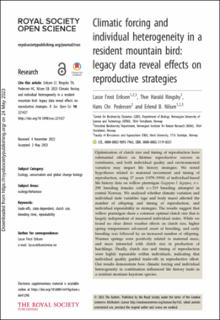Climatic forcing and individual heterogeneity in a resident mountain bird: legacy data reveal effects on reproductive strategies
Peer reviewed, Journal article
Published version

Åpne
Permanent lenke
https://hdl.handle.net/11250/3069971Utgivelsesdato
2023Metadata
Vis full innførselSamlinger
- Publikasjoner fra CRIStin - NINA [2397]
- Scientific publications [1423]
Originalversjon
10.1098/rsos.221427Sammendrag
Optimization of clutch size and timing of reproduction have substantial effects on lifetime reproductive success in vertebrates, and both individual quality and environmental variation may impact life history strategies. We tested hypotheses related to maternal investment and timing of reproduction, using 17 years (1978–1994) of individual-based life history data on willow ptarmigan (Lagopus l. lagopus, n = 290 breeding females with n = 319 breeding attempts) in central Norway. We analysed whether climatic variation and individual state variables (age and body mass) affected the number of offspring and timing of reproduction, and individual repeatability in strategies. The results suggest that willow ptarmigan share a common optimal clutch size that is largely independent of measured individual states. While we found no clear direct weather effects on clutch size, higher spring temperatures advanced onset of breeding, and early breeding was followed by an increased number of offspring. Warmer springs were positively related to maternal mass, and mass interacted with clutch size in production of hatchlings. Finally, clutch size and timing of reproduction were highly repeatable within individuals, indicating that individual quality guided trade-offs in reproductive effort. Our results demonstrate how climatic forcing and individual heterogeneity in combination influenced life history traits in a resident montane keystone species. trade-offs, state-dependent, clutch size, breeding time, repeatability
